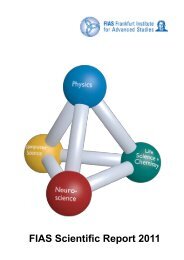FIAS Scientific Report 2010 - Frankfurt Institute for Advanced Studies ...
FIAS Scientific Report 2010 - Frankfurt Institute for Advanced Studies ...
FIAS Scientific Report 2010 - Frankfurt Institute for Advanced Studies ...
Create successful ePaper yourself
Turn your PDF publications into a flip-book with our unique Google optimized e-Paper software.
Thermodynamics of dense hadronic matter in chiral models<br />
Collaborators: C. Sasaki 1 , I. Mishustin 1,2<br />
1 <strong>Frankfurt</strong> <strong>Institute</strong> <strong>for</strong> <strong>Advanced</strong> <strong>Studies</strong>, 2 Kurchatov <strong>Institute</strong>, Russian Research Center, Moscow, Russia<br />
Model studies of hot and dense matter have suggested a rich phase structure of QCD at temperatures and<br />
quark chemical potentials of order ΛQCD. Our knowledge on the phase structure however remains limited and<br />
in particular, properties of baryons near the chiral symmetry restoration are poorly understood. The realistic<br />
modeling of dense baryonic matter must take into account the existence of the nuclear matter saturation point,<br />
i.e. the bound state at baryon density ρ0 = 0.16 fm −3 , like in Walecka type models. In this work we applied a<br />
parity doublet model to a hot and dense hadronic matter and explored the phase structure of a chiral symmetry<br />
restoration as well as a liquid-gas transition of nuclear matter. In the Figure we show the phase diagram of<br />
this model in mean field approximation. The liquid-gas transition survives up to T = 27 MeV. Above this<br />
temperature there is no sharp phase transition but the order parameter is still attracted by the critical point: the<br />
order parameter typically shows a double-step structure and this makes an additional crossover line terminating<br />
at the liquid-gas critical point. Another crossover line corresponding to the chiral symmetry restoration follows<br />
the steepest descent of the second reduction in 〈σ〉. With increasing temperature the two crossover lines become<br />
closer and finally merge.<br />
In contrast, the trajectory of a meson-to-baryon “transition” defined from the ratio of particle number densities<br />
is basically driven by the density effect with the hadron masses being not far from their vacuum values. The<br />
line is almost independent of the parameter set and goes rather close to the liquid-gas transition line. The chiral<br />
crossover and the meson-baryon transition lines intersect at (T, μB) ∼ (150,450) MeV. The parity doublet<br />
model thus describes 3 domains: a chirally broken phase with mesons thermodynamically dominating, another<br />
chirally broken phase where baryons are more dominant and the chirally restored phase, which can be identified<br />
with quarkyonic matter. It is worthy to note that this intersection point is fairly close to the estimated triple point<br />
at which hadronic matter, quarkyonic matter and quark-gluon plasma may coexist.<br />
In the mirror assignment of chirality to nucleons, dynamical chiral symmetry breaking generates a mass difference<br />
between parity partners and the chiral symmetry restoration does not necessarily dictate the chiral<br />
partners to be massless. The origin of a nucleon mass constrained by the scale anomaly in QCD is currently<br />
under investigation.<br />
T [GeV]<br />
0.25<br />
0.2<br />
0.15<br />
0.1<br />
0.05<br />
crossovers<br />
chiral 1st-order<br />
liquid-gas<br />
meson-baryon<br />
0<br />
0 0.2 0.4 0.6 0.8 1 1.2 1.4 1.6 1.8<br />
μB [GeV]<br />
The phase diagram of a two-flavored parity doublet model.<br />
Related publication in <strong>2010</strong>:<br />
1) C. Sasaki and I. Mishustin, Thermodynamics of dense hadronic matter in a parity doublet model, Phys. Rev.<br />
C 82, 035204 (<strong>2010</strong>).<br />
44

















